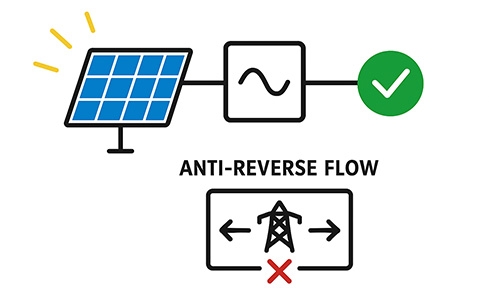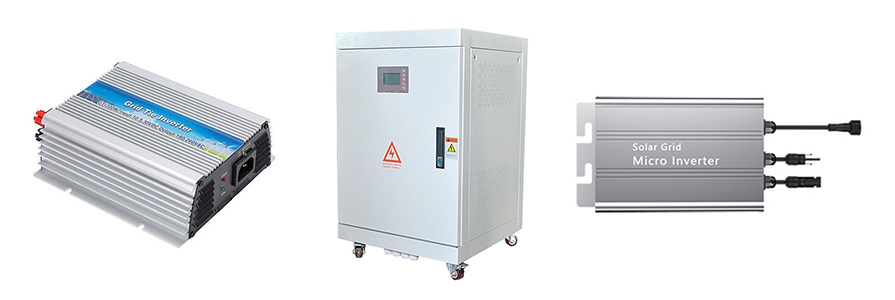In today’s era of energy transformation, photovoltaic (PV) power generation has become one of the most promising sources of clean and renewable energy. Within a PV system, the solar inverter plays a critical role in converting direct current (DC) into alternating current (AC). Depending on the application, different inverter types — grid-tie inverters, off-grid inverters, and microinverters — offer distinct advantages for various scenarios.
However, one significant challenge in PV systems is reverse current flow, also known as backfeeding. Normally, solar energy powers the local loads first. But when solar generation exceeds the load consumption, the surplus power can flow back into the grid — a phenomenon called “reverse current.” Most power grids have strict regulations against unauthorized reverse power injection, which can lead to penalties. For PV projects designed for self-consumption without grid export, implementing anti-reverse protection is essential to ensure energy self-sufficiency and system safety. So, what exactly is anti-reverse flow, how does it work, and what are the effective solutions? In the following, Inverter Online Store will provide a detailed introduction.
What Is Anti-Reverse Flow in a PV System?
In a PV system, solar panels generate DC electricity, which is processed differently by various types of inverters.
- Grid-tie inverters convert DC into AC synchronized with the grid in frequency and phase, enabling power exchange with the utility grid.
- Off-grid inverters convert DC into AC for standalone loads that are not connected to the grid.
- Microinverters are connected directly to individual solar arrays, converting DC from each panel into AC power.
When the PV generation exceeds the load consumption, the surplus energy flows backward into the grid, creating a reverse current. A PV inverter with an anti-reverse function can dynamically adjust its output power when generation exceeds consumption, ensuring that the solar power is used exclusively by local loads and preventing any unwanted power export to the grid.

Why Is Anti-Reverse Flow Protection Necessary?
There are several key reasons why installing anti-backfeed protection is essential in a solar power system:
- Grid policy restrictions: In some regions, local grid capacity or regulations prohibit power export. For instance, in remote or underdeveloped areas with weak grid infrastructure, unauthorized backfeeding could cause instability or even damage. Violating grid export limits may result in penalties or disconnection.
- Grid connection power limits: The grid often imposes strict limits on allowable connection capacity. If multiple solar systems in an industrial park inject excess power simultaneously, it can lead to grid voltage fluctuations, frequency instability, and power quality issues across the network.
- Self-consumption principle: Many PV systems are designed for self-use without export, meaning all generated electricity should be consumed locally. Anti-reverse flow devices ensure that any surplus energy does not feed back into the grid. For residential users, this enables energy independence and maximizes local solar utilization.
How Does the Anti-Reverse Flow Principle Work?
In practical applications, anti-reverse flow control relies on a smart meter and current transformer (CT) installed at the main incoming power line. These components continuously monitor real-time current and power direction.
When the system detects a reverse current (i.e., electricity flowing toward the grid), the anti-reverse meter communicates this data to the inverter through the RS-485 protocol. The inverter then reacts within seconds to adjust its power output:
- Grid-tie inverters reduce their AC output to prevent export.
- Off-grid inverters fine-tune their power delivery to avoid feeding energy into backup lines or unintended circuits.
- Microinverters adjust each panel’s output individually, keeping the net current flow to the grid near zero.
This dynamic power adjustment ensures effective anti-backflow performance and grid compliance.
What Are the Main Anti-Reverse Flow Solutions?
At Inverter.com, we introduce professional anti-reverse flow solutions combining solar inverters, anti-reverse meters, and anti-backflow boxes, tailored for different PV applications.
- Single-Phase Anti-Reverse System Solution: Required devices: grid-tie inverter, anti-reverse meter, and RS-485 communication cable. This configuration is ideal for residential solar systems. A single-phase solar inverter converts DC power into AC for household loads, while the anti-reverse meter monitors current direction and power flow. When reverse current is detected, it signals the inverter to promptly reduce output, preventing power export to the grid.
- Three-Phase Anti-Reverse System Solution: For small-scale residential systems, a direct DC anti-reverse meter can be connected to the inverter output terminals, enabling simple and efficient reverse current control. For high-power commercial PV systems, the solution involves CT sensors installed on the main grid connection. These sensors measure current flow, send proportional signals to the anti-reverse meter, and ensure accurate real-time monitoring. This approach is widely used in large buildings or industrial PV installations, where precise power management prevents reverse flow and enhances system stability.
- Multi-Inverter Anti-Reverse System Solution: In large-scale PV plants using multiple inverters (grid-tie, hybrid, or microinverters), all inverters can be linked through communication interfaces to a data collector. The collector manages system-wide monitoring and sends commands to each inverter during reverse flow events, ensuring coordinated power adjustment and overall grid protection.

What Are the Advantages of Different Inverter Types in Anti-Reverse Systems?
- Grid-Tie Inverters: Common in large-scale solar farms, these inverters efficiently convert DC to AC synchronized with the grid. They can respond quickly to anti-reverse signals, adjusting power output precisely to maintain balance between generation and consumption without grid disturbance.
- Off-Grid Inverters: Suitable for remote, stand-alone PV systems such as telecom towers or research stations. These inverters power loads independently and prevent any unwanted current leakage into external circuits. They ensure a stable power supply even without grid support.
- Microinverters: Each microinverter controls a single solar panel, providing a modular design, flexibility, and high efficiency. In anti-reverse systems, they can fine-tune each panel’s output to eliminate backfeeding, improve reliability, and simplify maintenance.
Conclusion
Anti-reverse flow solutions are crucial for meeting “no grid export” requirements in certain regions. Beyond regulatory compliance, they enhance grid stability, system safety, and energy efficiency, supporting smarter and greener solar power use.
As PV technology continues to evolve, innovations in solar inverter control, anti-backflow monitoring, and power management will further optimize solar system performance. Whether using grid-tie, off-grid, or microinverters, each plays a vital role in ensuring safe, efficient, and sustainable solar energy development for the future.
